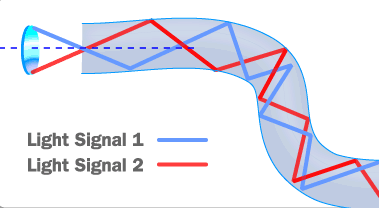- Related articles
- Optical Transceivers for Cisco WS-C3650-48PS-E Switch
- Optical Transceivers for Cisco SLM2024T-UK Switch
- The Things You Need to Know about 1000BASE-LR Ethernet Standards
- What is a BiDi transceiver?
- All Cisco GLC-BX40-U-I's information (List price, Specs, Datasheet PDF, Compatibility matr
- All Cisco CVR-X2-SFP10G's information (List price, Specs, Datasheet PDF, Compatibility mat
- Optical Transceivers for Cisco IE-2000-4TS-L Switch
- Difference between XENPAK and GBIC
- Optical Transceivers for Cisco SF300-24MP-K9-UK Switch
- What Is GYDXTW Fiber Optic Cable?

Introduction
It is clear that the data is transmitted along the fiber optic cable in form of pulses of light but many have no knowledge of how the movement is done. As a technician or an engineer, you should have knowledge on how the pulse moves along the cable. The pulse moves through the core in a bouncing motion from the cladding. It moves in a principle known as the total internal reflection. This blog will give you a clear understanding of how the pulse moves.
Discussion
The principle behind a fiber optic cable is that light is reflected along the cable until it reaches the other side, like in this diagram:
Although I know that the light is slowed down somewhat because it's not going through the air, I've always wondered about another factor: what about the fact that the light path is zig-zagged rather than straight? Doesn't that significantly increase the distance that the light has to travel? If so, by how much does it slow down the time the light takes to travel through the cable?

Light from a laser enters at one end of the fiber, striking the surface of the glass at an angle greater than the critical angle. We might expect a beam of light traveling in a clear glass pipe simply to leak out of the edges. But if light hits the glass at a really shallow angle (less than 42 degrees), it reflects back in again—as though the glass were really a mirror. This phenomenon is called total internal reflection. It's one of the things that keeps light inside the pipe.
Total internal reflection occurs at the glass surface and the light cannot escape until it reaches the other end of the fiber. Both visible light and infra-red can be used as they can travel long distances in the glass with very little being absorbed. A plastic coating prevents scratches on the glass surface which can allow the light to escape from the side of the fiber. Glass filaments are spun into diameters that vary from 5 to 100 microns and can carry something like 25,000 telephone calls, so an entire fiber-optic cable can easily carry several million calls.
Conclusion
In short, the pulse of light moves down the fiber optic cable using the principle of total internal reflection where it collides with the wall of the cable.





































































